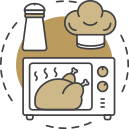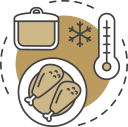As North East Oklahoma’s Premier food market leader, Reasor’s is proud to offer fresh, wholesome food products from locally familiar places and as diverse as our planet. Like you, we love gathering with family and friends around the table to enjoy wonderful freshly prepared meals, and we make every effort to ensure that the products we sell meet the highest quality requirements and the strictest safety regulations.
The journey from “farm to fork” ends in your kitchen and we want to make sure the daily meals you serve your family are always safe. Following the food safety basics below from our friends at the Partnership for Food Safety Education will help ensure each gathering at your table is a healthy and safe occasion.
 BACTERIA
BACTERIA
Bacteria is an invisible enemy ready to strike and make people sick. In fact, even though consumers can’t see bacteria – or smell it, or feel it – bacteria may already be invading food products, kitchen surfaces, knives and other utensils. But you have the power to fight bacteria and to reduce your risk of foodborne illness. It’s as easy as following these best practices for food safety:
Safe steps in food handling, cooking, and storage are essential to prevent foodborne illness. In every step of food preparation, follow these basic guidelines to keep food safe:
Clean | Wash hands and surfaces often.
Separate | Don’t cross-contaminate.
Cook | Cook to proper temperatures, checking with a food thermometer.
Chill | Refrigerate promptly.
 Clean: Cleanliness Helps Prevent Foodborne Illness
Clean: Cleanliness Helps Prevent Foodborne Illness
Because bacteria are everywhere, cleanliness is a major factor in preventing foodborne illness. By keeping everything clean that comes in contact with food, consumers can be assured they are helping to do their part to prevent foodborne illness. Even with food safety inspections of food establishments by Federal, State, and local government agencies, the consumer’s role is to make sure food is handled safely after it is purchased.
Bacteria can be spread throughout the kitchen and get onto hands, cutting boards, utensils, counter tops and food. To fight bacteria:
Always wash hands with warm, soapy water for at least 20 seconds:
- Before handling food
- After handling raw food
- After using the bathroom
- After changing a diaper
- After handling trash
- After blowing nose, coughing, or sneezing
- After handling pets
- After any activity which may contaminate hands
- Thoroughly wash, rinse, and sanitize all surfaces that come in contact with food products.
- This includes cutting boards, dishes, knives, utensils, counter tops, etc.
- Wash in hot, soapy water; rinse with clean, hot water;
- Sanitize with a solution of 1 tablespoon of unscented, liquid chlorine bleach per gallon of water. Apply sanitizer and let it remain on the surface for at least 1 minute;
- Let the surface air dry.
- When using a food thermometer, it is important to wash, rinse and sanitize the probe before using it, and after each use before reinserting it into another food.
- Consider using paper towels to clean up kitchen surfaces. If you use cloth towels wash them often in the hot cycle of your washing machine.
- Rub firm-skin fruits and vegetables under running tap water or scrub with a clean vegetable brush while rinsing with running tap water.
 Separate: Don’t Cross-Contaminate
Separate: Don’t Cross-Contaminate
Cross-contamination is the transfer of harmful bacteria to food from other foods, cutting boards, utensils, hands, etc. if they are not handled properly. This is especially true when handling raw meat, poultry, and seafood, so keep these foods and their juices away from already cooked or ready-to-eat foods and fresh produce. When handling foods it is important to prevent cross-contamination. By following these simple steps, you can prevent cross-contamination and reduce the risk of foodborne illness.
When Shopping:
Separate raw meat, poultry, and seafood from other foods in your shopping cart. Place these foods in plastic bags to prevent their juices from dripping onto other foods. It is also best to separate these foods from other foods at checkout and in your grocery bags.
When Refrigerating Food:
Place raw meat, poultry, and seafood in containers or sealed plastic bags to prevent their juices from dripping onto other foods. Raw juices often contain harmful bacteria. Store raw foods below cooked or ready-to-eat foods and fresh produce. Store eggs in their original carton.
When Preparing and Serving Food:
Wash hands and surfaces often. Harmful bacteria can spread throughout the kitchen and get onto cutting boards, utensils, countertops and other surfaces. Keep raw meat, poultry, seafood, and their juices away from other food. After cutting raw meats, wash cutting boards, dishes, utensils and counter tops with hot, soapy water. If possible, use one cutting board for fresh produce and a separate one for raw meats. Never place cooked food back on the same plate or cutting board that previously held raw food.
 Cook: Cook to proper temperatures, checking with a food thermometer.
Cook: Cook to proper temperatures, checking with a food thermometer.
Food is safely cooked when it reaches a high enough internal temperature to kill the harmful bacteria that cause foodborne illness. Use a food thermometer to measure the internal temperature of cooked foods. The best way to fight bacteria is to:
- Use a food thermometer which measures the internal temperature of cooked meat, poultry and egg dishes, to make sure that the food is cooked to a safe internal temperature.
- Cook roasts and steaks to a minimum of 145°F. All poultry should reach a safe minimum internal temperature of 165°F as measured with a food thermometer. Check the internal temperature in the innermost part of the thigh and wing and the thickest part of the breast with a food thermometer.
- Cook ground meat, where bacteria can spread during grinding, to at least 160°F. Information from the Centers for Disease Control and Prevention (CDC) links eating undercooked ground beef with a higher risk of illness. Remember, color is not a reliable indicator of doneness. Use a food thermometer to check the internal temperature of your burgers.
- Cook eggs until the yolk and white are firm, not runny. Don’t use recipes in which eggs remain raw or only partially cooked.
- Cook fish to 145°F or until the flesh is opaque and separates easily with a fork.
- Make sure there are no cold spots in food (where bacteria can survive) when cooking in a microwave oven. For best results, cover food, stir and rotate for even cooking. If there is no turntable, rotate the dish by hand once or twice during cooking.
- Bring sauces, soups and gravy to a boil when reheating. Heat other leftovers thoroughly to 165°F.
Refrigerate foods quickly because cold temperatures slow the growth of harmful bacteria. Do not over-fill the refrigerator. Cold air must circulate to help keep food safe. Keeping a constant refrigerator temperature of 40°F or below is one of the most effective ways to reduce the risk of foodborne illness. Use an appliance thermometer to be sure the temperature is consistently 40°F or below. The freezer temperature should be 0°F or below.
- Refrigerate or freeze meat, poultry, eggs and other perishables as soon as you get them home from the store.
- Never let raw meat, poultry, eggs, cooked food or cut fresh fruits or vegetables sit at room temperature more than two hours before putting them in the refrigerator or freezer (one hour when the temperature is above 90°F).
- Never defrost food at room temperature. Food must be kept at a safe temperature during thawing. There are three safe ways to defrost food: in the refrigerator, in cold water, and in the microwave. Food thawed in cold water or in the microwave should be cooked immediately. Foods must never be thawed on the counter.
- Always marinate food in the refrigerator.
- Divide large amounts of leftovers into shallow containers for quicker cooling in the refrigerator.
- Use or discard refrigerated food on a regular basis.
When certain conditions exist, bacteria can grow rapidly, increasing in numbers to the point where some can cause illness. Therefore, understanding the important role temperature plays in keeping food safe is critical. If we know the temperature at which food has been handled, we can then answer the question, “Is it safe?”
For additional information about food safety:
U.S. Dept. of Agriculture: 888-674-6854, www.fsis.usda.gov
U.S. Food & Drug Administration: 888-723-3366, www.fda.gov/Food/
U.S. Government Food Safety Information: www.foodsafety.gov/
Partnership for Food Safety Education: www.fightbac.org/
Food Safety Question?: See USDA Food Safety Website



